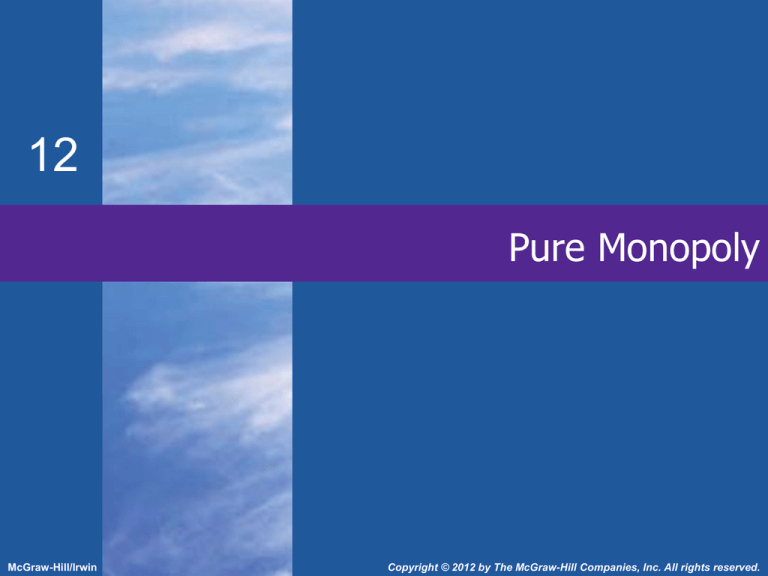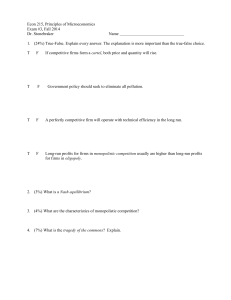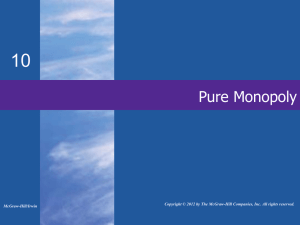
12
Pure Monopoly
McGraw-Hill/Irwin
Copyright © 2012 by The McGraw-Hill Companies, Inc. All rights reserved.
An Introduction to Pure Monopoly
• Single seller
• No close substitutes
• Price maker
• Blocked entry
• Non-price competition – mostly PR or
•
LO1
advertising the product
Examples
• Pure, regulated, near
Barriers to Entry
• Barrier to Entry: a factor that keeps
firms from entering an industry.
• Economies of Scale
• Legal Barriers: Patents and
Licenses
• Ownership of Essential Resources
• Pricing
LO1
Monopoly Demand
• Firm and market demand are same
• No governmental regulation
• Firm is a single-price monopolist
LO1
Monopoly Demand
Table 10.1 Revenue and Cost Data of a Pure Monopolist
Revenue Data
(1)
Quantity
of Output
LO1
Cost Data
(2)
Price
(Average
Revenue)
(3)
Total
Revenue
(1) X (2)
0
$ 172
$0
1
162
162
2
152
304
142
3
142
426
4
132
5
(4)
Marginal
Revenue
(5)
Average
Total Cost
(6)
Total Cost
(1) X (5)
(7)
Marginal
Cost
$ 100
$ 162 $ 190.00
(8)
Profit (+)
or
Loss (-)
$ -100
190
$ 90
-28
135.00
270
80
+34
122
113.33
340
70
+86
528
102
100.00
400
60
+128
122
610
82
94.00
470
70
+140
6
112
672
62
91.67
550
80
+122
7
102
714
42
91.43
640
90
+74
8
92
736
22
93.75
750
110
-14
9
82
738
2
97.78
880
130
-142
10
72
720
-18
103.00
1030
150
-310
Output and Price Determination
Table 10.2 Steps for Graphically Determining the Profit-Maximizing Output,
Profit-Maximizing Price, and Economic Profits (if Any) in Pure Monopoly
Step 1
Determine the profit-maximizing output by finding where MR=MC.
Step 2
Determine the profit-maximizing price by extending a vertical line
upward from the output determined in step 1 to the pure monopolist’s
demand curve.
Step 3
Determine the pure monopolist’s economic profit by using one of two
methods:
Method 1. Find profit per unit by subtracting the average total cost of
the profit-maximizing output from the profit-maximizing price. Then
multiply the difference by the profit-maximizing output to determine
economic profit (if any).
Method 2. Find total cost by multiplying the average total cost of the
profit-maximizing output by that output. Find total revenue by
multiplying the profit-maximizing output by the profit-maximizing
price. Then subtract total cost from total revenue to determine the
economic profit (if any).
LO2
Misconceptions of Monopoly Pricing
• Not highest price
• Total profit
• Possibility of losses
LO2
Economic Effects of Monopoly
• Income transfer
• Cost complications
• Economies of scale
• Simultaneous consumption
• Network effects
• X-Inefficiency
• Rent seeking expenditures
• Technological advance
LO3
Assessment and Policy Options
• Antitrust laws
• Break up the firm
• Regulate it
• Government determines price and
•
LO3
quantity
Ignore it
• Let time and markets get rid of
monopoly
Price Discrimination
• Price discrimination
• Charging different buyers different
•
LO4
prices
• Price differences are not based on
cost differences
Conditions for success:
• Monopoly power
• Market segregation
• No resale
Regulated Monopoly
• Natural monopolies: Market demand
•
•
LO5
curve intersects ATC where ATC is
still declining
Socially optimal price
• P=MC
Fair return price
• P=ATC









